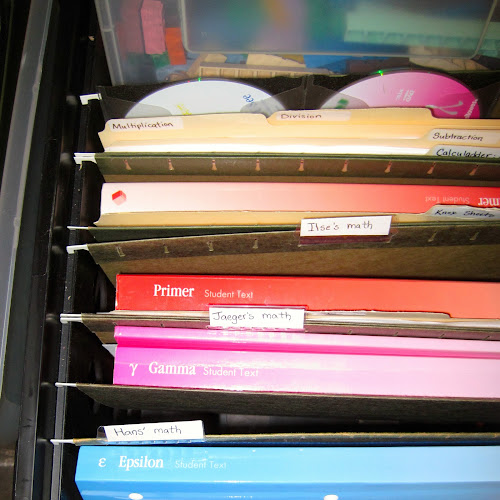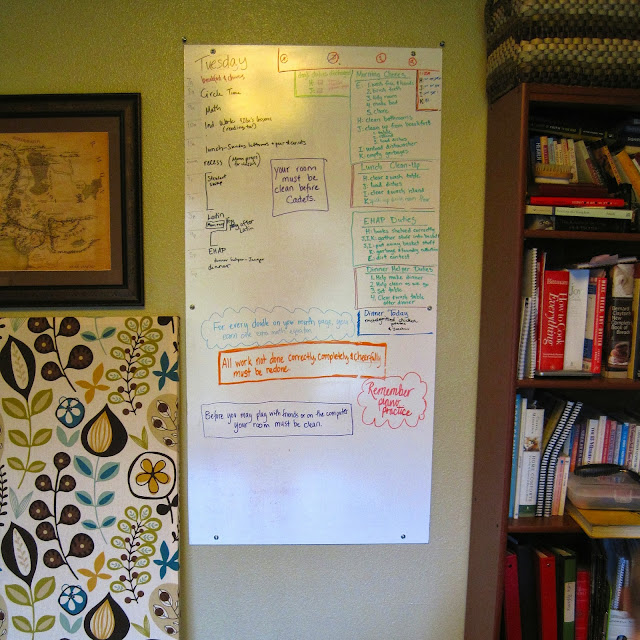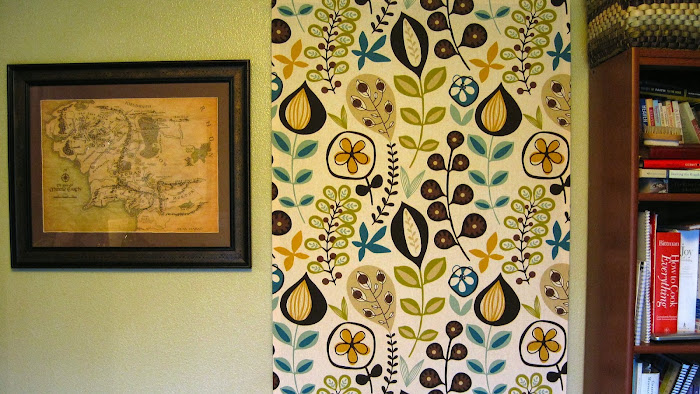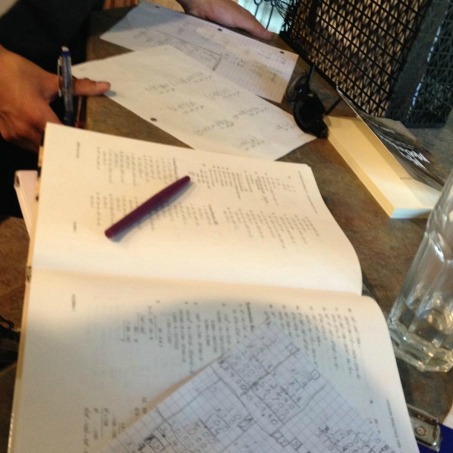There’s no doubt about it: Homeschooling makes a house messy. It seems like having a homeschool room – especially an organized homeschool room – would make the mess go away or at least stay away.
But it doesn’t work that way, at least not at my house.
I believe doing school in your normal family living areas is actually
We’ve been homeschooling for over a decade without a dedicated school room or separate school space, and over the years I’ve developed some favorite organization hacks that make learning and living work together, even with all the extra stuff.
We homeschool without a schoolroom. Like many homeschoolers, the kitchen table is where much of our work happens. We use our kitchen table, we use our dining room table, we use our couch, and we make due with the space we have.
However, all the stuff does need to be contained. Everything has to have a home. A schoolroom provides a go-to home for all the stuff of homeschooling. When there is no such dedicated room, it means we have to be creative with our normal living spaces so that they can both house the stuff of our learning days while still also providing, well, living spaces – preferably ones that are peaceful and welcoming rather than cluttered and chaotic.
These are my three favorite homeschool hacks that give stuff homes and keep our work accessible and portable so that our home doesn’t feel overrun with homeschooling.
You don’t need a school room to homeschool
The truth is that I’d rather have a playroom than a schoolroom, a place for the toddlers and preschoolers to freely set up a block city complete with railroad tracks, a place for the air hockey table we inherited, a place for the computers that are used both for work and for play.
Our house layout doesn’t have the space for both a playroom and a schoolroom. We have space for two tables on the main level, and rather than making the dining room or the kitchen eat-in area a bonafide schoolroom (one open to the kitchen and the other open to the living room), I’d rather have them be flexible and versatile, without schoolish clutter.
So, it’s a matter of the space available and our preferences for how to use it. If you have a room that works set aside for school stuff, more power to you. If you don’t, I want to share strategies for making it work without having it feel like the school stuff is ruling the house.
It’s all a matter of using the space you have in a way that fits your family and your patterns.
The most important part of any homeschool room
Whether you have a dedicated schoolroom or not, the most important feature of where school happens is the writing surface. Reading can happen anywhere there’s light, but a solid, uncluttered, comfortable writing space is essential for written work.
Keeping tables clear is hard. It is also essential.
If the table is going to be multi-functional, it’s going to have to be cleared and cleaned over and over and over again, multiple times a day. Just call it practice.
It’s like folding laundry on my bed – if that’s where I’m folding it, then I have to take care of it by the end of the day before I crawl under the covers.
If we school at the dining room table, then it all has to be put away before dinner. It’s a feature, not a bug. It’s a bonus, not a con.
Even if you have a homeschool space set up, you might find kids still gravitate toward particular areas of the house or particular tables or chairs. I always did my schoolwork at the dining room table, even though we had desk space in the basement when I was growing up.
If we can offer our kids multiple spaces in which they can do their work, they can settle in and find a place that appeals to them – a small, self-directing, personal choice – that gives them a little ownership and individuality in their day. That seemingly insignificant ability to make a choice about how their work is done is actually a huge morale booster.
And what homeschool doesn’t need a morale boost? Especially in January and February.
What matters is that the work is done and done well. If it’s done in the brightly lit, center-of-it-all dining room, the lap-desk on the couch, the computer table in the basement, the kitchen bar, or wherever else there happens to be writing surface available, it’s done and that’s what counts. Let some variation and option into the equation.

Just because they wouldn’t be able to change their desk situation in a classroom or change their cubicle location in a corporate setting does not mean they shouldn’t have the option in their own home with their own studies.
Which is more human: home or cubicle? Which are we preparing them for: self-directed pursuits or worker bee compliance? J
ust because they wouldn’t have the option in the “real world” doesn’t mean they shouldn’t actually have the option in their own actual world – we should strive to be more like the ideal world than the real world, even in such little ways as allowing our kids to read or write in the location that appeals to them most if they can still produce quality work from their location of choice.
Provide the options your space and living patterns allow. Don’t sweat what you don’t have. They don’t need a schoolroom. They won’t languish if there is a schoolroom.
They don’t need multiple places to work. They won’t die if they only have one choice. They don’t need to be confined and regulated.
Scope out your options, think outside the conventions, be willing to experiment, and see if you can’t come up with some homey, appealing arrangements that suit your space and your family.
Homeschool Room Ideas: Shelves for Stuff
The thing about homeschooling without a schoolroom is that I don’t want my house to look like we are a homeschooling household.
I’m not at all embarrassed to be a homeschooler, but I want a house that looks welcoming and inviting and calming, not one that has timelines in the entry way or schoolish posters in the dining room.
I decorate with books, but I don’t want to decorate like a kindergarten classroom or like homeschooling is our primary identity, the thing that takes over not only our days, but even our walls.
During school hours it does take over all our surface areas, it seems, but I want to be able to EHAP& and have the house look reasonably “normal.”
Therefore, shelves.
The real trick about having a tidy or organized house is for everything to have a home. Things without homes are clutter. Things with homes can be put away, leaving space for life to happen. Mid-day, the house might look chaotic, but by evening, if everything has a place to go, it can look decently in order again: like my kitchen counter day-in-the-life post shows.
What sort of shelves do you use for giving homes to your school materials?
Organize Your Homeschool Room with Bins
Let me sing the praises of bins.
I love bins.
They keep like things together. They corral messes. They make things easy to grab and go.
When you homeschool across the whole house (and sometimes out of doors!), storing things in bins makes life easier and lesson time smoother. Keeping things corralled and together makes it simpler to put it away out of sight and to move it to wherever work is being done.
Organize homeschool papers with bins
Using plastic filing containers with hanging folders is a great way to keep a stock of various sorts of papers at hand. They can also be used for filing completed work away or for holding work for the coming week or term.
A bin can be pulled from a high shelf and replaced easily – much more easily than paper in their plastic wrap.
Organize homeschool stuff by blocks of time
My favorite way to organize bins is by “blocks of time.” There’s a bin for our twice-a-week “elementary lessons” in the afternoon with the books and supplies we use then. There’s a bin for the Kindergarten & 1st grader’s lessons that happen 3x a week or so. There’s a bin for the 6th grader to contain his materials and another one for the 4th grader. There’s the crate with a hanging folder for each student’s math workbooks and drill pages.
When I dedicate a chunk of time in our school day to a particular set of lessons.

Bins, of course, are great for storage. We have a lot of books in our house, and one coping strategy I have is to box up (or bin up) the books on the periods of history we are not currently studying. This way, about 100 books are kept out of rotation and are fresh and exciting again when I pull them out.
I even have bins with bins inside, but you probably aren’t as crazy as I am.
Related: 20 Homeschool Organization Hacks
Portable Homeschool Teacher’s Office
Maybe this counts as a homeschool bin, but my craft-tote turned supply-tote is prettier than most of my plastic bins. It’s a small craft tote that I bought from WalMart years ago. My intention was to use it as a craft tote, but my projects never fit neatly into it. It’s more for crafty stuff, really.
My yarn projects were always too bulky for the compartments and my cross stitch project (that I’ve had in progress for 8 years) was too small. So it sat on the shelf for awhile until I was casting about, wondering how to corral some of my school day teacher supplies.
I think we were going to do some of our school at the park, and I wanted something where my pens and notecard and other small things wouldn’t get lost in the bottom of a bag. I grabbed my empty craft bag and it’s been in heavy use ever since.
It’s open, so everything is handy. It has handles, so it’s easy to grab and bring along. It has compartments built in, so things stay organized.

In my teacher tote lives my dry erase markers, a small dry erase board, my pens, my clipboard, a lotion bar and lip balm, any book I want to keep handy, and there’s still room to spare to stick in whatever I need to hold onto.
Homeschool Room Organization: Clipboards
I suppose clipboards are just as useful whether you have a schoolroom or not, but because we don’t have a specific desk space for each child (or many workbooks!), clipboards make our school days smoother.
I bought colored plastic clipboards a couple years ago, so each child has a clipboard in his own color. That means I can tell at a glance whose clipboard is sitting out on the counter after I’ve told them to put their stuff away.
Their clipboard holds their weekly assignment sheet, plus any pages they need – handwriting, blank map, etc. – plus they use it to hold anything they are currently working on. So, if they’re writing an outline, their paper goes on their clipboard as they pull books or search wikipedia. The clipboard means they have a writing surface wherever they go.
When I grade their math and mark corrections to be made, I can put it back on their clipboard and know it won’t get misplaced (well, ok, it’s much less likely to be misplaced, anyway).
It is super-handy having everyone use a color-coded clipboard.
Dining Room Homeschool Room Hack: Covered Whiteboard
I think one of the handiest things I’ve set up is a whiteboard that is visible in the room everyone spends most time in. We have a spot to clearly post reminders and chore lists and schedules. Consequences can be noted and remembered, special to-do items posted, and an outline of the day made visible to all. It cuts down on questions I’m asked, it cuts down on decision-making for me, and it keeps us all on the same page.


It’s actually a large piece of shower board my husband bought at the hardware store and mounted on the wall for me. Not only was this cheaper than a large whiteboard, but he could also cut it to exactly fit the space we had.
However, I don’t want a marked-up whiteboard as a permanent part of our decor. It rather spoils the atmosphere of an evening dinner with friends or a relaxing moment by the fire.
So, my husband also made me a cover.

It’s just fabric stretched and stapled over a wood frame. It it easy to pull off and put back on. It means I can quickly cover up the chaotic jumble of details about our days and pretend our life is serene and calm.
What unconventional uses have you discovered to make homeschooling without a school room work for you?
Share in the comments!
The post Homeschooling Without a Schoolroom appeared first on Simply Convivial.

